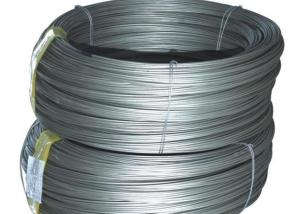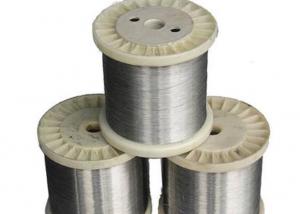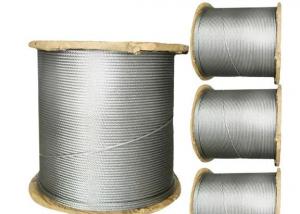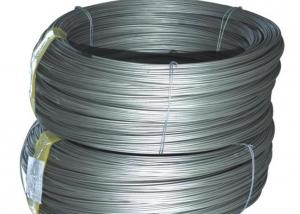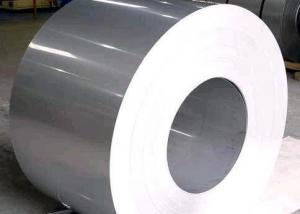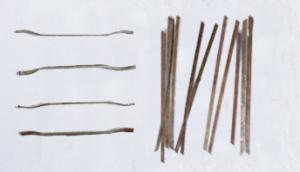Stainless Steel Wire
- Loading Port:
- China Main Port
- Payment Terms:
- TT or LC
- Min Order Qty:
- 1 Ton m.t.
- Supply Capability:
- 2000 Tons Per Month m.t./month
OKorder Service Pledge
OKorder Financial Service
You Might Also Like
Stainless Steel Wire
1.Grade: SS 200,300,400 series
2.Dia: 0.1mm-100mm
3.Length:500m-2000m/Reel
4.Surface: Bright
5.Certificate: Fortune 500, SGS, ISO 9001:2008
6.Test: Salt Spray over200 hours
7.MOQ:500kg
8.Delivery: Within 20 days
9.Packing: Reel, wooden box or according to your requirement
10.Payment terms: China Main Port or CIF ANY PORT
11. Application: Tie wire, pins, lashing, forming wire, filters, gaskets, elevators, safety wire, shaped and flat wire, conveyors, jewelry, springs, brush welding, electrical, wire line, craft and many more applications.
|
Main Grades |
C % |
Si % |
S % |
P % |
Mn % |
Cr % |
Ni % |
Mo % |
Cu % |
|
S30400 |
<0.08 |
<0.75 |
<0.015 |
<0.045 |
<2 |
18.05-19 |
8.01--8.25 |
<0.6 | |
|
304H |
0.04-0.1 |
<0.75 |
<0.015 |
<0.045 |
<2 |
18.05-19 |
8.01--8.25 |
<0.5 | |
|
304Hc1 |
0.03-0.05 |
<0.75 |
<0.015 |
<0.045 |
<2 |
18.05-19 |
8.01-8.25 |
1.2-1.6 | |
|
304Hc |
0.03-0.05 |
<0.75 |
<0.015 |
<0.045 |
<2 |
18.05-19 |
8.01--8.25 |
2-3 | |
|
304Hc3 |
0.03-0.05 |
<0.75 |
<0.015 |
<0.045 |
<2 |
18.05-19 |
8.01--8.25 |
3-3.5 | |
|
304ES |
<0.08 |
<0.75 |
<0.015 |
<0.045 |
2-3 |
16.05-17 |
6.01-6.3 |
1.5-3 | |
|
304M2 |
0.05-0.08 |
<0.75 |
<0.015 |
<0.045 |
2-3 |
18-18.5 |
7-8.1 |
<0.6 | |
|
304M3 |
0.05-0.08 |
<0.75 |
<0.015 |
<0.045 |
2-3 |
18-18.5 |
8.01-8.25 |
<0.6 | |
|
304L |
<0.035 |
<0.75 |
<0.015 |
<0.045 |
<2 |
18.05-19 |
8.01--8.25 |
<0.6 | |
|
321 |
0.04-0.08 |
<0.75 |
<0.015 |
<0.045 |
<2 |
17-18 |
8.01--8.25 |
||
|
316L |
<0.035 |
<0.75 |
<0.015 |
<0.045 |
<2 |
16.05-17 |
10.01--10.35 |
2.01-2.2 |
<1 |
|
316 |
0.04-0.08 |
<0.75 |
<0.015 |
<0.045 |
<2 |
16.05-17 |
10.01--10.35 |
2.01-2.2 |
<1 |
|
316LCu |
<0.035 |
<0.75 |
<0.05 |
<0.045 |
<2 |
16-17 |
10-10.5 |
2-2.25 |
|
|
ER316L |
<0.04 |
0.65 |
<0.03 |
<0.04 |
1.0-2.5 |
18-20 |
11.1-12 |
||
|
201CU |
<0.08 |
<0.75 |
<0.015 |
<0.045 |
8-9.5 |
13.05-14 |
4.01-4.25 |
2-3 | |
|
D667 |
<0.08 |
<0.75 |
<0.015 |
<0.045 |
13-14 |
13-14 |
0.7-1.5 |
1.5-3 | |
|
D665B |
<0.08 |
<0.75 |
<0.015 |
<0.045 |
14-16 |
10.05-11 |
<1.2 |
0.5--1.5 | |
|
202B |
0.1-0.15 |
<0.75 |
<0.015 |
<0.045 |
9-10 |
17.05-18 |
4.5-5 |
||
|
D669 |
0.08-1.0 |
<0.75 |
<0.015 |
<0.045 |
14.5-16 |
11-12 |
<1.2 |
0.5-1.5 | |
|
200CU |
<0.08 |
<0.75 |
<0.015 |
<0.045 |
11-12 |
13-14 |
1-2 |
1.5-2.5 |

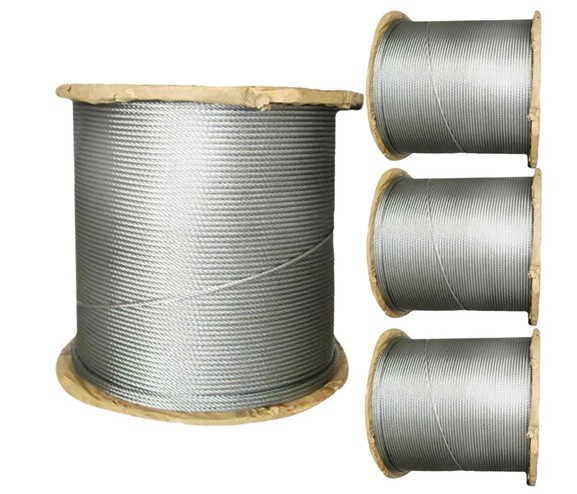
- Q:Is stainless steel wire suitable for wire rope fences?
- Yes, stainless steel wire is suitable for wire rope fences. It offers exceptional strength, durability, and resistance to rust and corrosion, making it ideal for outdoor applications. Additionally, stainless steel wire provides an attractive and sleek appearance, enhancing the overall aesthetic of the fence.
- Q:What are the different types of stainless steel wire grades for different applications?
- Various applications require different types of stainless steel wire grades. Some commonly used grades include: 1. Austenitic stainless steel (300 series): Known for its excellent corrosion resistance, high ductility, and good formability, this grade is commonly used in food processing, chemical industries, and architectural applications where resistance to chemical and atmospheric corrosion is needed. 2. Martensitic stainless steel (400 series): Characterized by its high strength and hardness, this grade is often used in cutlery, surgical instruments, and industrial equipment that require high wear resistance. 3. Ferritic stainless steel (400 series): Similar to martensitic stainless steel, this grade offers better corrosion resistance. It is commonly used in automotive exhaust systems and heat exchangers that require resistance to stress corrosion cracking. 4. Duplex stainless steel: Combining the properties of austenitic and ferritic stainless steels, this grade provides high strength, good weldability, and improved resistance to stress corrosion cracking and pitting. It is commonly used in chemical processing plants, oil and gas industries, and marine environments. 5. Precipitation-hardening stainless steel: Heat treatment allows this grade to achieve high strength and hardness. It is often used in aerospace components, nuclear reactors, and high-performance tools that require good mechanical properties. To choose the appropriate stainless steel wire grade, it is important to consider factors such as corrosion resistance, strength, formability, and cost. Consulting with a materials engineer or stainless steel supplier can help determine the most suitable grade for a specific application.
- Q:What are the different types of stainless steel wire rope thimbles?
- There are several different types of stainless steel wire rope thimbles, including standard thimbles, heavy-duty thimbles, open-style thimbles, and swage thimbles. Each type has its own unique design and functionality, catering to different applications and requirements.
- Q:What are the different types of stainless steel wire used in filtration applications?
- There are several types of stainless steel wire commonly used in filtration applications, including 304, 316, and 316L stainless steel. These grades of stainless steel offer excellent corrosion resistance, durability, and high tensile strength, making them suitable for various filtration processes. Additionally, they can withstand high temperatures and harsh environments, making them ideal for applications in industries such as oil and gas, food and beverage, pharmaceuticals, and water treatment.
- Q:Can stainless steel wire shelves be used for storage in wet environments?
- Stainless steel wire shelves are perfectly suitable for storage in wet environments. The reason for this is that stainless steel possesses exceptional resistance to corrosion and rust, rendering it an optimal material for areas with moisture and humidity. Furthermore, stainless steel is also highly hygienic and effortless to clean, making it an ideal choice for storing items in settings such as kitchens, bathrooms, or outdoor areas that may come into contact with water or other liquids. The wire design of these shelves allows for improved air circulation and drainage, effectively preventing the accumulation of water or moisture. In summary, stainless steel wire shelves are an enduring and dependable option for storage in wet environments.
- Q:What are the different types of stainless steel wire springs?
- Various industries commonly use different types of stainless steel wire springs. Some of the most frequently used types include: 1. Compression Springs: These springs resist compressive forces and are ideal for storing energy or absorbing shock. They find extensive applications in the automotive, aerospace, and industrial sectors. 2. Extension Springs: These springs resist tensile forces and are commonly used for pulling or extending objects. You can commonly find them in garage doors, trampolines, and various mechanical devices. 3. Torsion Springs: These springs resist twisting or rotational forces and are typically used for storing and releasing energy. They are often present in door hinges, clock mechanisms, and various automotive components. 4. Wire Form Springs: These springs are created by bending wire into shapes like hooks, clips, or rings. They have a wide range of applications, including electrical connectors, fasteners, and suspension systems. 5. Constant Force Springs: These springs provide a consistent force over a specific range of motion. They are often used where a steady force is required, like in retractable seat belts or window shade mechanisms. 6. Die Springs: These heavy-duty compression springs are specifically designed for high-stress applications. They are commonly found in stamping and molding machines, as well as heavy machinery and equipment. It should be noted that the selection of the appropriate type of stainless steel wire spring depends on various factors, such as load capacity, temperature resistance, corrosion resistance, and environmental conditions. Seeking advice from a spring manufacturer or engineer can help determine the most suitable type for a specific application.
- Q:What are the different types of stainless steel wire ropes used in mining?
- The mining industry utilizes various stainless steel wire ropes that are tailored for its demanding conditions and applications. These wire ropes are specifically engineered to withstand the harsh environment encountered in mining operations. Several types of stainless steel wire ropes commonly used in mining include: 1. 6x19 Class Wire Rope: Comprised of six strands, with each strand containing 19 wires, this wire rope strikes a balance between flexibility and strength. It is suitable for a range of mining applications like hoisting, hauling, and lifting. The 6x19 class wire rope is renowned for its resistance to wear and fatigue, making it reliable in rugged mining settings. 2. 6x36 Class Wire Rope: This wire rope consists of six outer strands, each containing 36 wires. It offers increased flexibility compared to the 6x19 class wire rope, making it ideal for applications that require enhanced bending capabilities. The 6x36 class wire rope is commonly employed in mining operations that involve heavy-duty lifting and dragging tasks. 3. 6x37 Class Wire Rope: Similar to the 6x36 class wire rope, this wire rope also consists of six outer strands. However, it contains 37 wires in each strand, providing even greater flexibility and resistance to fatigue. The 6x37 class wire rope is commonly used in mining applications that demand high strength and flexibility, such as deep shaft sinking and underground mining operations. 4. 8x19 Class Wire Rope: Composed of eight outer strands, with 19 wires in each strand, this wire rope offers improved resistance to wear and increased strength compared to the 6x19 class wire rope. It finds common use in mining applications involving heavy loads and high levels of abrasion, such as conveyor systems and material handling equipment. 5. 8x36 Class Wire Rope: Consisting of eight outer strands, with 36 wires in each strand, this wire rope excels in bending capabilities and resistance to fatigue. It is suitable for mining applications that require repetitive bending or flexing, like cranes, derricks, and winches used in mining equipment. These diverse stainless steel wire ropes employed in mining are purposefully designed to meet the specific demands of various mining applications. They offer superior strength, flexibility, and resistance to corrosion and wear, ensuring the safety and efficiency of mining operations.
- Q:Can stainless steel wire be used for wire EDM cutting?
- Yes, stainless steel wire can be used for wire EDM (Electrical Discharge Machining) cutting. Wire EDM is a process that utilizes a thin, electrically conductive wire to cut through conductive materials with extreme precision. Stainless steel wire is commonly used in wire EDM cutting due to its high strength, corrosion resistance, and excellent electrical conductivity. It can effectively cut through various materials, including metals like steel, aluminum, titanium, and even exotic alloys. The use of stainless steel wire in wire EDM cutting allows for intricate and complex shapes to be achieved with tight tolerances, making it a versatile choice for many manufacturing applications.
- Q:Is stainless steel wire suitable for food processing applications?
- Indeed, stainless steel wire proves to be appropriate for food processing applications. Renowned for its exceptional resistance to corrosion, stainless steel emerges as the perfect material for employment within food processing settings that frequently come into contact with water, chemicals, and food products. Furthermore, its effortless cleanability and sanitization capabilities guarantee the upholding of stringent hygiene standards. Added to this, stainless steel wire exhibits impressive strength and durability, enabling it to endure the demanding nature of food processing operations whilst preserving its structural integrity. In conclusion, stainless steel wire stands as a dependable and secure option for food processing applications.
- Q:Can stainless steel wire be used for marine applications?
- Indeed, stainless steel wire is suitable for marine applications. Due to its resistance to corrosion, stainless steel is an optimal material for use in marine environments that are frequently exposed to saltwater, moisture, and other unforgiving conditions. It finds extensive use in a variety of marine applications such as rigging, wire rope, fishing nets, and marine electronics. Thanks to its exceptional resistance to rust, corrosion, and staining, stainless steel wire guarantees durability and longevity in marine settings. Furthermore, stainless steel possesses strength, reliability, and the ability to withstand high levels of tension and stress, making it an appropriate choice for marine applications that demand robustness and endurance.
1. Manufacturer Overview |
|
|---|---|
| Location | Hebei,China |
| Year Established | 2009 |
| Annual Output Value | Above US$1 million |
| Main Markets | Asia, Middle East,America |
| Company Certifications | CE, CCC, ISO90001 |
2. Manufacturer Certificates |
|
|---|---|
| a) Certification Name | |
| Range | |
| Reference | |
| Validity Period | |
3. Manufacturer Capability |
|
|---|---|
| a)Trade Capacity | |
| Nearest Port | Tianjin |
| Export Percentage | 0.3 |
| No.of Employees in Trade Department | 4 People |
| Language Spoken: | English;Chinese |
| b)Factory Information | |
| Factory Size: | Above 5,000 square meters |
| No. of Production Lines | 3 |
| Contract Manufacturing | OEM Service Offered;Design Service Offered |
| Product Price Range | Lower |
Send your message to us
Stainless Steel Wire
- Loading Port:
- China Main Port
- Payment Terms:
- TT or LC
- Min Order Qty:
- 1 Ton m.t.
- Supply Capability:
- 2000 Tons Per Month m.t./month
OKorder Service Pledge
OKorder Financial Service
Similar products
New products
Hot products
Hot Searches
Related keywords
